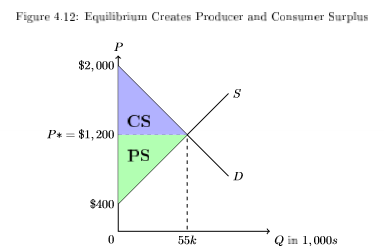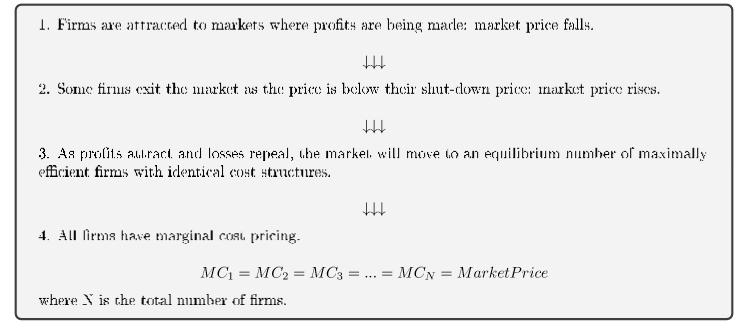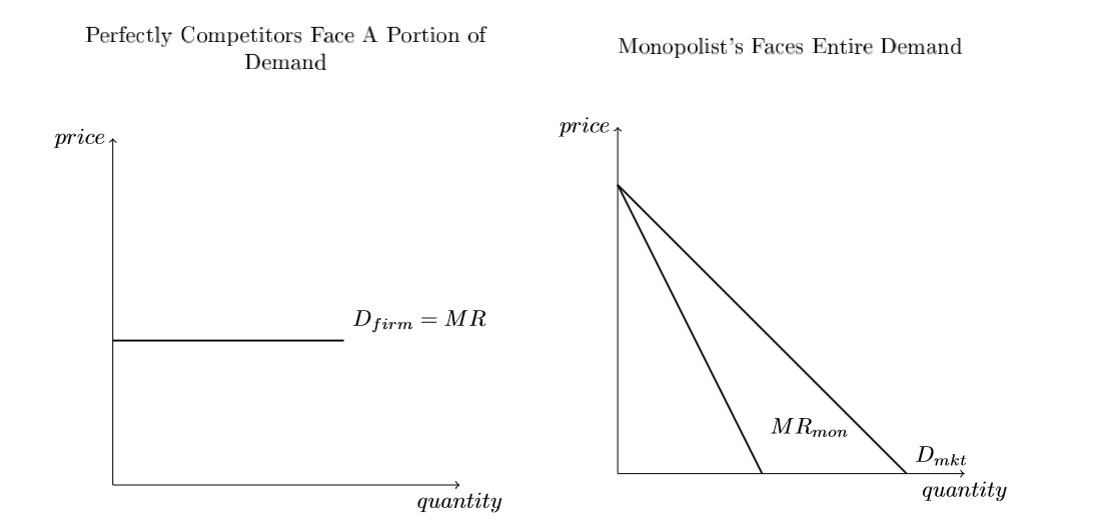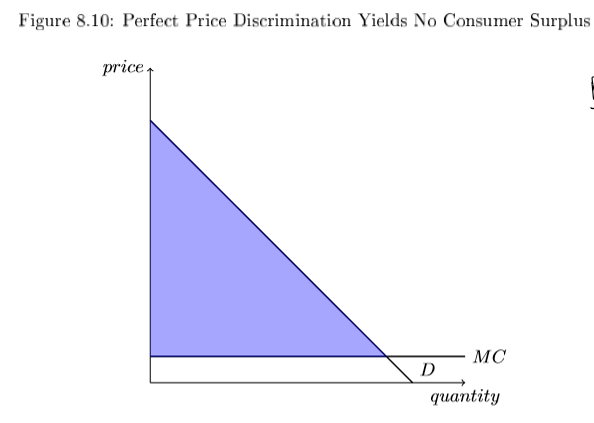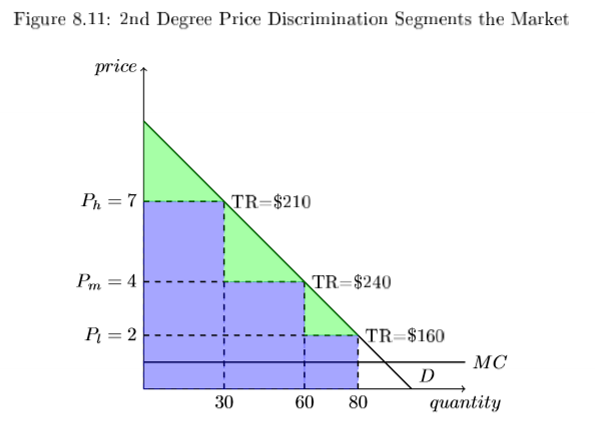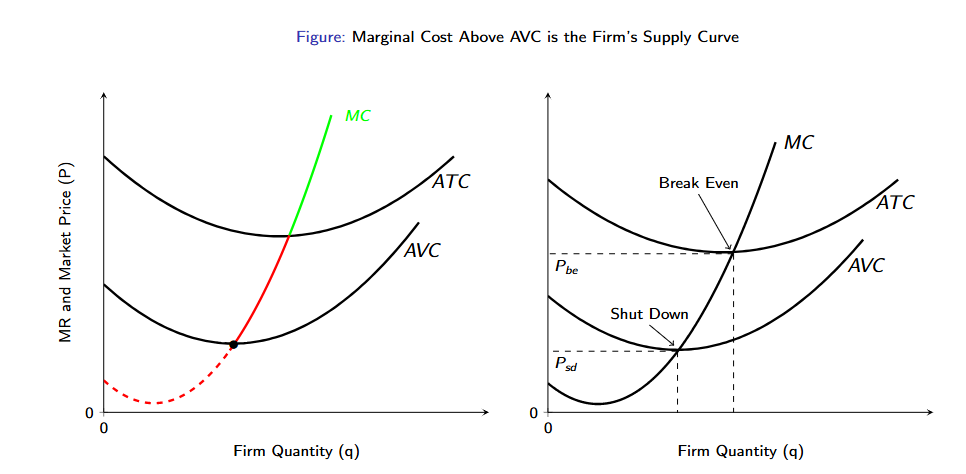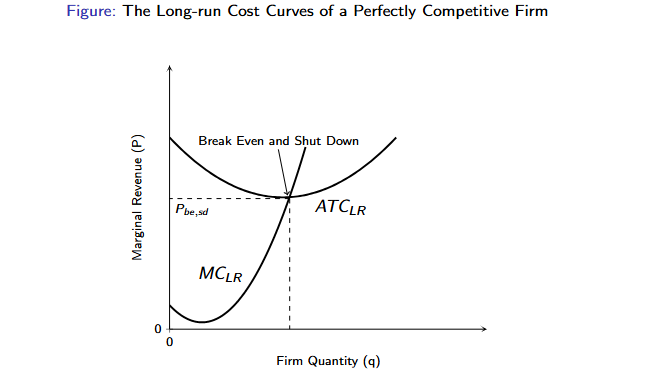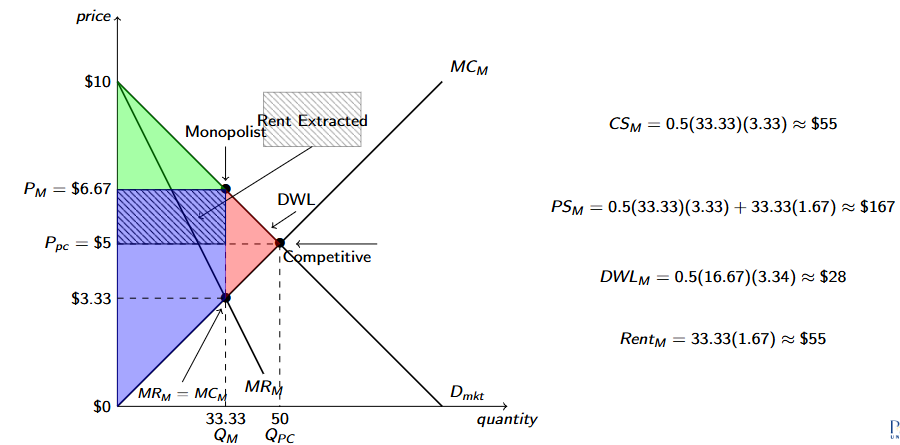ECON 251-H - Midterm Exam 2 Study Guide
Readings
Chapter 4 - Turning the Crank
Outputs depends on the inputs of capital (K) and labor (L): Q = f(K,L)
Firms hire inputs until marginal product per dollar is equalized across inputs
example: Ron Swanson’s tomato farm, fertilizer (capital) and children (labor), maximizes profit
Firms have a goal to maximize profit and want to minimize costs
We often are in interested in the Capital Intensity and Labor Intensity of a production function which refers the importance of either capital or labor
The supply chain of a firm is the entire process from raw materials to final purchase of a good
Production can be thought of as the ability of a firm to combine labor and capital units to produce output
If the prices falls below average variable cost (AVC), the firm shuts down
The market supply is built by horizontally summing all firms’ supply curves
In order to produce more, firms will either require more capital or more labor or more of both
Returns to Scale - refers to the value that is added to the production function when a firm adds capital and labor to their function
Consumer Surplus (CS) = value consumers gain above price paid
Producer surplus (PS) = value producers gain above cost of production
Total Economic Surplus (TES) = CS + PS —→ maximized at equilibrium
Elasticity of supply measures responsiveness of quantity supplied to price changes
production complexity ↓ elasticity
supply chain complexity ↓ elasticity
storability ↑ elasticity
Elastic (E>1) ——> producers respond strongly to price changes
Inelastic (E<1) —→ producers barely adjust quantity
Profit Function: {Profits}=\pi=(P\cdot q)-C(q)
The MC curve is the firm’s supply curve
Profit is maximized when marginal cost = market price (MC = P) in competition
If price falls below average variable cost (AVC), the firm shuts down
What does fixed cost have the potential to be what economists call?
A Barrier to Entry
Willingness to Accept (WTA): a firm will choose to not sell their product until the market price is at least equal to the reservation price
A firm’s cost structure (including fixed costs) is what determines their WTA
The producer’s problem is to maximize their profits
MR > MC then profits are rising
MR < MC then profits are falling
MR = MC then profits are stabilized
Market price is set at market equilibrium
Supply Curve Shifters
characteristic
relationship with supply
cost of production
negative
input market disruption
negative
firm entry
positive
expected price
negative
Increase in demand → higher P, higher Q
Increase in supply → lower P, higher Q
Decrease in demand → lower P, lower Q
Decrease in supply → higher P, lower Q
Both curves can shift; total change depends on which shifts more
Chapter 5 - It’s Just Markets All the Way Down
Invisible Hand Theory
Invisible hand Theory is said to push and pull goods across the economic system so that they are used efficiently
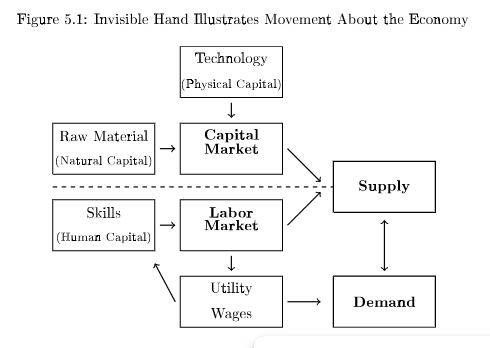
An efficient economy is good for society.
As efficiency continues, capital and labor will flow to those parts of the economy that are the most profitable.
This ultimately leads to a maximization of resources and wealth creation, benefiting both producers and consumers
ex: as the personal computer came on the scene in the 1980s, demand for typewriters began to fall, so capital and labor began to leave the typewriter market because less profits were available there. Then, with new technological capital and new skilled labor flowing into the personal computer market, producing computers became wildly profitable.

Creative Destruction: the idea is that over time industries are born, grow, and eventually are replaced with other industries.
The cost of economic progress, is as economics transition from old industries into new ones, then labor markets that served the old industries will have less demand and greater supply of labor causing wage decline and unemployment
Structural Unemployment: if new industries require new skills that the old industry laborers do not have, then those individuals will experience structural unemployment
Unemployment Assistance: assists the recently unemployed by paying them a portion of their previously earned income
Economic Efficiency vs. Social Efficiency
economically efficient for creative destruction to move economies from industries to industries, but human suffering is caused (social)
Partial vs. General Equilibrium
Supply and Demand Framework
Isolating to a single market = partial equilibrium
we are only considering what occurs within a single market
ex: what happens to the supply for apples if orange supply is cut due to a blight in orange crops
not only a single market’s change, but the general economy’s = general equilibrium
Firms acquire capital and labor by purchasing them from their own distinctive markets
Capital Market = the market for a piece of capital that firms use in the production of their goods and services
when a firm invests in new capital, we call this business fixed investment = key driver for economic growth
Labor Market = the market for employees that firms employ in the production of their goods or services
When firms allocate resources effectively within these markets, they not only enhance productivity but also bolster overall economic efficiency.
Human capital refers to the skills/understanding that employees bring to their firms specific needs
Cost Function Up Close
C = VC(q) + FC
VC = rk+ wl
r is the rental rate of capital and w is the wage rate of labor
Capital markets are intermediary markets, creating the inputs that firms use to produce their final goods
Natural Capital - the natural resources like oil, forests, and ore deposits
Physical Capital - human-made inputs like computers, delivery trucks, and steel
Financial Capital - the various financing options that allow businesses to invest in themselves
Scarce Capital - the expensive stuff: cobalt; space shuttle
Abundant Capital - relatively cheap, water, computer chips, server space
Rental Rate of Capital = Price of Capital (called rate since capital depreciates over time)
The rental rate of capital is related to the interest rate by the following equation r = (i + o)Pk
i = interest rate, o is the depcreation rate of capital, and Pk is the per unit cost of capital
When interest rates go up, so does the rental rate of capital.
Rental rate of capital is set by a market process
How does a firm decide how much capital to purchase?
Know Marginal Product of Capital (MPk)
MPk = change in q/change in k
Know Value of the Marginal Product of Capital
MPk x market price (P*)
A firm will purchase capital up until the rental rate is equal to the value of MPk
Labor Markets
Demand for Labor (Dlabor) = created by firms
comes from firms maximizing their profits at the current wage rate
demand for labor curve represents the willingness to pay for labor of a firm
Supply of Labor (Slabor) = created by individuals
comes from individuals deciding what level of employment would maximize their utility at the current wage rate.
supply of labor curve represents the willingness to accept of individuals to supply their own labor units to the market
Marginal Product of Labor
MPl = change in q/change in l
Value of marginal Product of Labor
MPl x P*
Chapter 7 - Stiff Competition
What is Competition?
Competition: firms are not able to pick prices
Competition means that firms are not able to pick prices
As markets grow more competitive, we expect firms to lose price-setting power.
As markets grow less competitive, we expect firms to gain price-setting power
the less price-setting power a market has, the more economically efficient that market will be
When firms are able to set their own prices, consumers have less say in changing the prices in the market
example: see-saw as the balance of power within a market
so, when producers are “heavier” they force consumers to pay higher prices. meanwhile, when consumers are “heavier” they are able to keep prices low
Monopolies: markets with a single producer
Monopsonies: markets with a single consumer
Market Power: ability to influence the price of the market
Competitive Barrier: reduces the ability of firms to replicate the object or process for profit-making, ex: patents
Product Differentiation: the process of distinguishing a product from similar offerings in the market, allowing firms to command higher prices and foster brand loyalty among consumers
Brand Loyalty: the tendency of consumers to continuously purchase a specific brand due to their positive experiences, perceived quality, and emotional connection. ex: apple iphones due to market power
Assumptions of Perfect Competition:
there are numerous enough buyers and sellers that no one entity directly affects a price
information is either known or can be accessed by buyers and sellers
buyers and sellers are free to enter and exit the market at any time
there is little to none production differentiation, and consumers therefore have no brand loyalty
Firms in perfectly competitive markets are Price-takers, meaning they have no market power and maximize profits by picking the best quantity supply response to the market price.
Market Prices = Price Signals
In competitive markets, signals are efficient
Firms do not sell unless it is rational for them to do so and consumers don’t buy unless it is rational for them to do so
In a market lacking competition, price signals do not maximize economic efficiency.
Competition ensures that no rent extraction is occurring
Firms maximize their profits by producing at a quantity where Marginal Revenue Equals Marginal Cost; MR = MC for Pi Maximization
Since profits can only be maximized when MR = MC, then the change in profits must equal zero.
It is rational for a firm to set MR = MC because that is how profits are maximized
Costs and Revenues as Metrics
Total Cost in the Short Run: TC=VC+FC
What do variable costs (VC) refer to?
the costs associated with production
Even if the firm chooses to Exit the Market, they will still be liable for their short-run FC
Average Total Cost (ATC) - tells the firm how much their costs are per unit of production
What is a distinct difference between VC and FC?
as production goes up, VC goes up
as production decreases, VC goes down
FC does not change regardless of how much their firm produces
ATC = sum of AVC and AFC
ATC = TC/q = VC/q + FC/q
AVC = VC/q; AFC = FC/q
The demand curve facing perfect competitors is Perfectly Elastic - showing the price-taking behavior of competitive firms.
any price greater than market price, and firm sells none
any price less than market price, and the firm no longer maximizes profit
Short - Run Profit Maximization
Producer responds to a market price of $70 by producing 58 units (MR=MC) which producers TR (blue rectangle)
To calculate TC, find ATC at the profit maximizing quantity
since TC = ATC/q we can compute TC by computing ATC times q (red rectangle)
Producer’s profits are TR - TC, which is shown by the green rectangle

Perfect Competition in the Short-run
Profits = TR - TC ( TC = VC + FC) = P x q - VC(q) - FC
If the firm produces 0 units of the product, then profits are -FC
firms will only stay open if doing so is no worse than: Profits > -FC
TR - TC > -FC
Psd <= AVC
Marginal Cost Above AVC is the Firm’s Supply Curve
MC = AVC is where shut-down price is for short-run
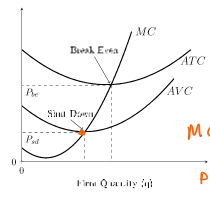
When MR = MC….

There is an economic truth to the rationality of staying open - at least until there is no possibility of profiting - while earning negative profits
Perfect Competition in the Long-Run
In the long-run, there full theoretical extent of The Invisible Hand is realized
The idea behind the short and long-run is that they will represent two separate ways of thinking about economic markets
In the long run, firms will no longer accept negative profits in the long-run
Long-run Break Even Price = Long-run Shut Down Price
ATClr = MClr
Cost lowering is the only way for perfectly competitive firms to try to earn greater profits
As market price falls, the firm has to reduce their quantity supply in order to maintain profit maximization
Profits attract firms to a market, causing the price to fall so then some firms exit the market and process repeats itself until only the most efficient (least cost) firms are left in the market.
Dynamics of Perfect Competition in the Long-run
Since profits will attract firms to the market, this process repeats until there are no profits in the market
The theoretical outcome of a perfectly competitive market is called the Long-run Zero profit Condition of Competitive Markets
it is very likely that once a firm is able to innovate to a lower cost structure, the firm will retain market power and the market will move away from perfect competition
Chapter 8 - King of the Mountain
What is Market Power?
Market Power is what happens when the mechanism of competition is absent
If competition is sufficient, the market sets the price and firms are then price-takers
When the assumptions of competitive markets are relaxed, firms gain price setting power and profits.
meaning, markets that lack competition behave differently than competitive ones.
Monopsony - a market with a single consumer
Different Types of Market Power - all may create Rent Extraction
Resource Procurement
Governmental Lobbying
Brand Loyalty
Spatial Advantage
Rent Extraction: the value of consumer surplus lost to producer surplus when the price rises above that which would be set by a market
Economic inefficiency does not equate to all consumers suffering.
some consumers enjoy things like brand loyalty or innovative products
if market power allows the firm to raise the price of their product, this will necessarily cut some consumers out of the market
What is the problem with market power?
it moves us away from the efficient outcome of a competitive market
In markets with considerable market power, intervention may in fact increase competition and therefore efficiency.
Freely non-competitive markets create Dead Weight Loss - intervention that increases competition would potentially be efficient
What was established in the early 20th century to combat the rampant monopolization and collusion of industries like steel, oil, etc.?
anti-trust laws
Capitalism - which relies on the efficiency of markets - requires some form of regulation in order to maintain competition
Non-competitive markets will equilibrate inefficiently, and that persists into the long-run
Anti-trust laws are necessary for market-based/capitalistic economies to remain economically efficient
The monopolization of a market by a monopolist is market failure.
as the free market is not expected to produce the most economically efficient outcome.
US Anti-Trust Laws
the sherman act
the ftca
clayton act
Monopolies
market that is controlled by a single firm = monopolist
the monopolist faces the entire demand curve of the market, which is downward sloping
marginal revenue is an important difference between the perfect competitor and the monopolist
the marginal revenue for the monopolist is ALWAYS the demand curve with twice the slope
Perfectly competitive markets maximize economic and social efficiency
total economic surplus is maximized at the equilibrium of a competitive equilibrium with marginal cost pricing.
additionally, no rent is extracted by the producers
Contested Monopolies
If a competitive firm is able to innovate, differentiate their product, and/or erect barriers to entry, this could erode the number of firms in the market over time until only one firm remains = Contested Monopoly
Profit-maximizing firm will always produce where MR = MC, and monopolists follow this but they will always produce less products than a competitive market
Monopolist will charge a price which is the MWTP for the good at their profit maximizing quantity level (move up from Qm and hits demand curve at Pm (6.67).

Monopolist market price (p*) is higher than a competitive outcome
Rent extraction by a monopolist specifically comes from their ability to charge a price greater than what the price would be in a competitive market
Natural Monopolies
Fixed costs are so high that barriers to entry naturally exist
Natural monopolies exhibit economies of scale: the average total cost of product falls as the firm produces more
Ex: water and electricity utilities, where start-up costs and economies of scale mean having a single regulated firm is economically efficient
ATC curve being downward sloping as production increases shows the firm has economies of scale
Fair Market - the production level where a monopolist would earn zero profit
at a competitive market point, a firm is making less than zero profits
What do policy-makers use in order for a monopolist to produce at a fair market or competitive outcome?
Price Controls and Subsidize Production
otherwise, price controls may eliminate the reason for a monopolist to produce
Price Discrimination
Under price discrimination, firms are able to extract economic rents by charging different prices to different consumers
Firms can earn even higher profits by differentiating their prices to different consumers
First Degree Price Discrimination: a monopolist is able to extract all economic rent as firms charge consumers their max WTP and no consumer surplus exists
Second Degree Price Discrimination: firms have separate prices to meet different consumers WTP.
Third Degree Price Discrimination: firms split market into different demand curves based on consumers different WTP
ex: door dash for regular consumers vs college students
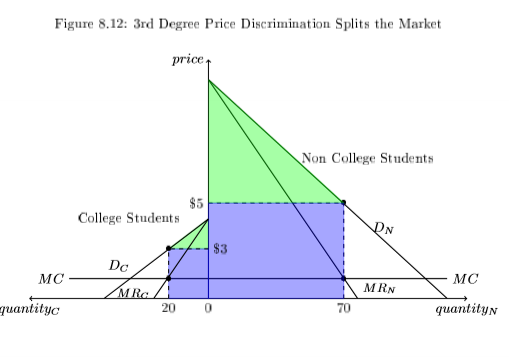
What are some of the different versions of price discrimantion?
personal discrimination, group discrimination, product discrimination
Monopolistic Competition
Product Differentiation - gives firms monopoly power for the short-run. But, as long as the market has free entry, perfect information, and many producers, this will not last in the long-run
Monopolistic Competition: a market where firms will be able to innovate and create short-run market power, but because the market is competitive and barriers to entry do not exist, this power is short-lived
What are some of the implications of monopolist competition?
Monopoly power may be limited as long as barriers to entry are limited or eliminated
Monopolistic competition is NOT a market failure as it does not persist into the long-run
Continual attempts to innovate will both be lucrative to firms and you don’t have the long-run dead weight loss associated with monopolies
What is the key issue?
how to make certain that markets are competitive, while firms within markets would prefer to have market power
most small businesses in the US would be considered to operate within monopolistically markets, which is why small businesses struggle SO MUCH
Oligopolies
Oligopoly: a very small number of competing firms, each with some portion of market power
Market Share: the portion of all sales in a market generated by a firm
Firms have greater market power with more market share, oligopolistic markets often involve a significant amount of advertising, product differentiation, and/or lobbying. Brand loyalty is especially important.
Oligopolies tend to get less competitive and more concentrated over time, which is why they are so concerning.
The HHI refers to the extent the market is controlled by a specific number of firms by squaring the market share of each firm and summing the values
HHI = s²+s²+s²+s²+s²+s²
market becomes more concentrated as the HHI increases
Mergers and Acquisitions can cause oligopolistic markets to become more concentrated over time
we can generally assume that oligopolistic markets, even under good circumstances, have significant dead weight loss
Vertical Mergers and Horizontal Mergers
specifically, horizontal mergers are concerning because those firms were previously in competition with each other form a single firm
There is a concern oligopolistic markets will collude and form cartels, which is another way monopolistic behavior occurs, so collusion is mostly illegal.
Varian 18 (Optional)
Short-Run: Some inputs (capital K) are fixed.
Long-Run: All inputs can vary → no fixed cost.
Firms choose cost-minimizing input bundles given output q.
MC < AC → AC falls, MC > AC → AC rises (same intuition as average grades).
The AC curve is U-shaped due to diminishing marginal returns.
Derived from the expansion path (the cost-minimizing combinations of L and K for each q).
Long-Run Average Cost (LRAC) envelope of short-run ACs.
Economies of Scale: Output ↑ → AC ↓ → increasing returns.
Diseconomies of Scale: Output ↑ → AC ↑ → decreasing returns.
Minimum Efficient Scale (MES): Lowest q where LRAC is flat and constant returns hold.
Firms hire inputs so the last dollar spent on each input yields equal marginal product.
This is the same rule Ron Swanson used for fertilizer vs. children in Problem 2.
Varian 19 (Optional)
Individual firm’s supply curve = MC above AVC.
Market Supply = horizontal sum of individual supply curves.
As price rises → each firm produces more → entry ↑ in long run.
Entry/exit drive profits → 0.
Long-run equilibrium at P=MC=ACP=MC=ACP=MC=AC.
Industry supply becomes perfectly elastic (horizontal).
Producer Surplus (PS): Area under price above supply (MC).
Consumer Surplus (CS) from demand side; total surplus = CS + PS
Competitive equilibrium maximizes total surplus (Pareto efficient)
When firms gain market power, P > MC, Q ↓, and DWL appears
Government policy can regulate P → MC to restore efficiency.
Slides
Slides - 4 - Turning the Crank
Market Assumptions
Competitive Markets
Key Feature: Firms do not set prices; they adjust to market prices.
Neo-Classical Economic Assumptions
Buyers and sellers are rational.
Information is readily available to all market participants.
Buyers seek to maximize utility; sellers seek to maximize profits.
Additional Simplifying Assumptions for Producers
Price-Taking Behavior: Sellers are price-takers and do not set prices themselves.
Market Entry/Exit: Sellers are able to easily enter or exit markets.
Production Function
The Producer’s Problem: Maximize profits through effective use of resources.
Production Function Formula: q = f(k, l)
where:
q = quantity produced
k = capital used
l = labor employed
Every Business Uses Labor and Capital to Produce Goods/Services
Output: Defined as the Quantity Produced.
Capital Intensity & Labor Intensity:
Utilization of resources varies among businesses, such as:
Labor-intensive: example: call center.
Capital-intensive: example: oil drilling company
Supply Chain Overview
The Supply Chain encompasses the entire process from raw material acquisition to final product consumption:
Cultivation, extraction, or purchase of intermediate goods.
Transport to production facilities for assembly.
Movement of assembled goods to retailers for consumer purchase.
Complexity in modern supply chains requires businesses to navigate numerous strategic decisions.
Production can be thought of as the ability of a firm to combine labor and capital units to produce output
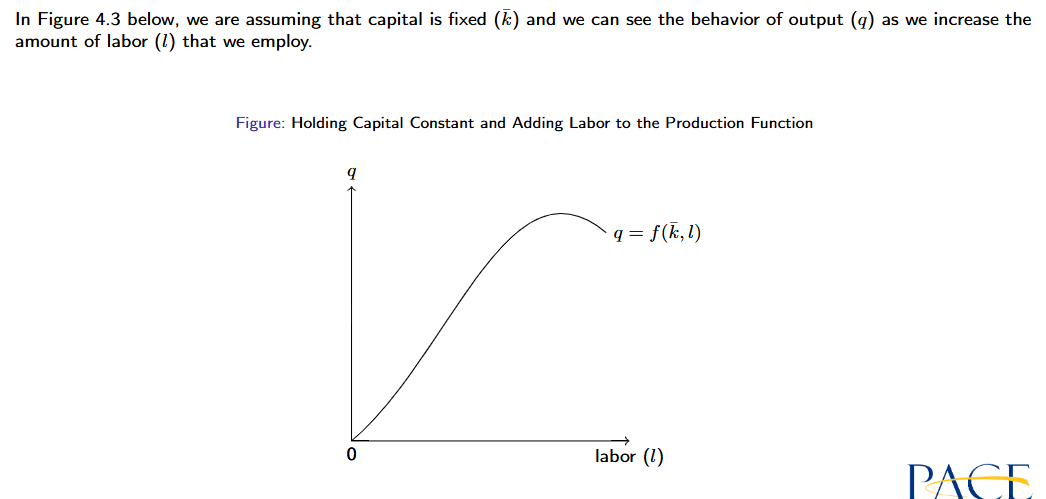
Returns to Scale
Definition: Effects on production outputs as capital and labor inputs change.
Increasing Returns to Scale: Production rises by more than the proportional increase in capital/labor.
Decreasing Returns to Scale: Production rises by less than the proportional increase in capital/labor.
Constant Returns to Scale: Production increases exactly matches proportional increase in capital/labor.
Returns to Scope: refers to the production improvements that arise from a firm choosing to expand the number of things that they produce
Integrations
Vertical Integration: Merging with/acquiring upstream or downstream entities within the supply chain.
Horizontal Integration: Merging with/acquiring competitors in the same market segment.
Understanding Costs and Revenues
Profit Calculation: {Profits}=\pi=(P\cdot q)-C(q)
where:
P = market price
q = quantity produced
C(q) = total cost of production
Total Revenue (TR): Money received from selling goods.
Marginal Revenue (MR): Change in total revenue from selling one additional unit:
{MR}={\frac{\triangle TR}{\triangle q}}Cost Function: C(q) = V C(q) + F C
where:
V C(q) = Variable Costs
F C = Fixed Costs
Marginal Cost (MC): Change in total cost due to an additional unit produced:
{MC}={\frac{\triangle TC}{\triangle q}}
Marginal Profits and Decision-Making
Assume: firms are price takers
Marginal Profits Formula:
{marg\pi}={\frac{\triangle\Pi}{\triangle q}}=MR-MCDecision Rule:
If MR > MC: Profits are increasing.
If MR < MC: Profits are decreasing.
If MR = MC: Profits are stable.
Graphical Representation: The relationship is represented as an inverted-U shape, reflecting the effects of the Law of Diminishing Marginal Returns.
The reason why profits are represented by an ”inverted-U” function is because of the Law of Diminishing Marginal Returns. Firms would love to just be able to produce more and more of a product to make more and more profit, but more and more production creates more and more cost.

Profits are maximized when MR = MC or when marginal profits are zero
MR = \frac{\Delta TR}{\Delta q}
The MR of a firm in a competitive market is always equal to the market
price (P ∗).MR = \frac{\Delta TR}{\Delta q}=P\ast
Equilibrium and Market Dynamics
Firm Behavior: Firm responds to market prices, influencing production decisions.
Market Price Dynamics: As market price rises, firms typically produce more; as it falls, production decreases.
Supply Curve Relation: In competitive markets, the supply curve corresponds to the MC curve.
Aggregate Market Behavior
Total Supply Curve Calculation: Horizontal summation of individual supply curves to create market supply curve.
Market Equilibrium: Intersection of supply and demand curves determine equilibrium price ( P^* ) and equilibrium quantity ( Q^* ).
Price Elasticity of Supply
Formula:

Interpretation: Degree of quantity supplied response to price changes.
Elasticity Classifications:
Relatively Inelastic: when Esi is less than 1
Relatively Elastic: when Esi is more than 1
Determinants of Price Elasticity of Supply
Characteristic | Effect on Elasticity |
|---|---|
Production Complexity | Decrease elasticity |
Supply Chain Complexity | Decrease elasticity |
Storability | Increase elasticity |
Supply Curve Shifters
Characteristic | Relationship with Supply |
|---|---|
Cost of Production | Negative |
Input Market Disruption | Negative |
Firm Entry | Positive |
Expected Price | Negative |
Slides - 7 - Stiff Competition
Understanding Competition in Economics
Competition determines market evolution:
Increased competition leads to a loss of price-setting power for firms.
Decreased competition gives firms more price-setting power.
Economically efficient markets are characterized by less price-setting power.

Assumptions of Perfect Competition
There are numerous enough buyers and sellers such that no single entity can influence prices.
Accessible and known information for both buyers and sellers.
Freedom for buyers and sellers to enter and exit the market without impediments.
No product differentiation; consumers exhibit no brand loyalty.
Profits and Price-taking Behavior
Profit Maximizing Quantity
Firms in a competitive market are characterized as price-takers.
Firms respond to market prices by determining their Profit Maximizing Quantity.
Profit Representation
Figure: Profits exhibit an inverted-U shape relative to quantity produced.
Costs and Profit Calculation
Basic Formula:
Profits = Total Revenue (TR) - Total Cost (TC)
Marginal Change Representation:
Profits = △TC/q
Marginal Revenue Representation:
Profits = △TR/q
Marginal Profit Analysis
If {Marginal Profits} > 0:
Producing one additional unit increases profits.
If {Marginal Cost} > {Marginal Revenue} after optimal quantity q^*:
Producing one additional unit decreases profits.
Profit maximized when:
{Marginal Revenue} = {Marginal Cost} ➔ {Marginal Profits} = 0
Short Run vs. Long Run
Total Cost in Short Run:
{Total Cost}_{ {SR}} ={Variable Costs (VC)} + {Fixed Costs (FC)}
Rule #1 (Short Run): Produce only if you can cover fixed costs.
Total Cost in Long Run:
{Total Cost}_{ {LR}} = {Variable Costs (VC)}
Rule #2 (Long Run): Produce only if you can cover total costs.
Cost Curves

Shut-down Rule
Profit Calculation for Shutdown Scenario:
{Profits}_{ {shut}} = - {FC}
Firms remain operational if:
{Profits}_{ {open}} > - {FC}
Short-run Shut Down Rule formula:
{TR} - {TC} > - {FC}
Further simplified to:
{P} x q - {VC} - {FC} > - {FC}
Therefore, {P} x q > {VC}
Resulting in: {P}_{ {open}} > {VC/q}
Subsidization and Supply Curves
Long-Run Cost Curves
Market Dynamics
The Story:
Firms are drawn to profitable markets, leading to market price decreases.
Firms exit when market prices fall below shut-down prices, causing market prices to rise.
Market equilibrium is achieved with the optimal number of efficient firms sharing identical cost structures.
Marginal costs equal market prices across all firms:
Slides - 8 - King of the Mountain
Overview of Market Dynamics
Key Concepts
Markets can be dominated by a few firms, leading to high prices and blocking entry for rivals.
Economically powerful entities can exclude others, emphasizing the importance of inclusive economic institutions.
Inclusive markets promote equality and economic opportunity for the majority.
Political institutions that are inclusive can counteract monopolistic tendencies, maintaining market inclusivity.
Market Power
Conceptual Metaphors
Market power likened to gravity, suggesting that relaxing competitive assumptions leads to real-world inefficiencies.
Evaluation of Market Efficiency
Importance of understanding what efficiency means in the context of telecommunications and similar sectors.
Barriers to Entry in Markets
Factors Reducing the Number of Firms
High fixed costs associated with resource procurement.
Lobbying efforts that create favorable conditions.
Brand loyalty that hinders consumer mobility.
Innovation protection via patents.
Spatial advantages that benefit incumbent firms.
Market Failures and Rent Extraction
Market Inefficiencies
Discussion of market failures as instances when markets do not efficiently allocate resources.
Non-competitive markets lead to inefficiencies in production and consumption.
Rent Extraction Explained
Firms convert consumer surplus into producer surplus through market power.
Impact of monopolistic structures on market pricing and consumer experience.
Monopolist Behavior
Demand and Pricing
Monopolists face total demand curve and determine prices based on their market power:
Demand Equation: D: P = a - bQ
Marginal Revenue: MR: P = a - 2bQ
Examples of Market Scenarios
Competitive market equilibrium and how monopolies disrupt it.
Visualization of demand curves and monopolistic pricing.
Market Efficiency
Should leave DWL as $0
Should leave Rent Extraction as $0
Contested Monopoly
Rent is extracted, and DWL exists
ex:
Outcomes:
